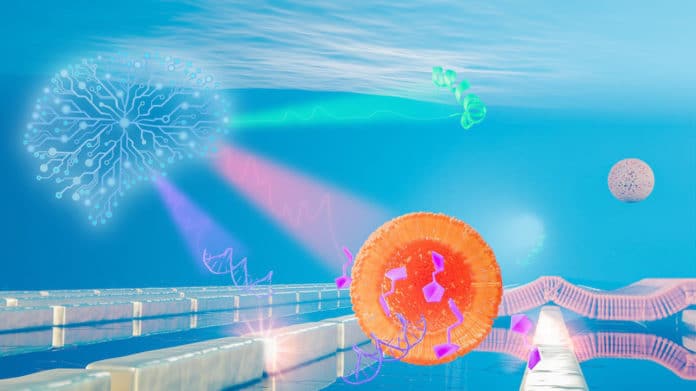Using metasurfaces, infrared light, and artificial intelligence, EPFL scientists have developed AI-powered nanosensors that can observe all major biomolecule classes of the nanoworld without disturbing them.
Hatice Altug, the head of the Bionanophotonic Systems Laboratory, said, “Tuning into this tiny world and being able to differentiate between proteins, lipids, nucleic acids and carbohydrates without disturbing their interactions is of fundamental importance for understanding life processes and disease mechanisms.”
The key to this biosensor is infrared light. Infrared light is invisible to the human eye, yet it can feel in the form of heat.
Aurélian John-Herpin, a doctoral assistant at Altug’s lab and the first author of the publication, said, “If you imagine audio frequencies instead of infrared frequencies, it’s as if each molecule has its own characteristic melody. However, tuning into these melodies is very challenging because, without amplification, they are mere whispers in a sea of sounds. To make matters worse, their melodies can present very similar motifs making it hard to tell them apart.”
These issues were solved by using metasurfaces and AI. Metasurfaces offer outstanding light manipulation capabilities at the nanoscale, hence activating functions beyond what is otherwise seen in nature.
In this study, scientists precisely engineered meta-atoms made out of gold nanorods that mimics as amplifiers of light-matter interactions by tapping into the plasmonic excitations resulting from the collective oscillations of free electrons in metals.
John-Herpin said, “In our analogy, these enhanced interactions make the whispered molecule melodies more audible.”
“AI can be imagined as a complete beginner musician who listens to the different amplified melodies and develops a perfect ear after just a few minutes and can tell the melodies apart, even when they are played together – like in an orchestra featuring many instruments simultaneously.”
When these metasurfaces were augmented with AI, the biosensor detect biological assays featuring multiple analytes simultaneously from the major biomolecule classes and resolving their dynamic interactions.
Altug said, “We looked in particular at lipid vesicle-based nanoparticles and monitored their breakage through the insertion of a toxin peptide and the subsequent release of vesicle cargos of nucleotides and carbohydrates, as well as the formation of supported lipid bilayer patches on the metasurface.”
This pioneering AI-powered, metasurface-based biosensor will open up exciting perspectives for studying and unraveling inherently complex biological processes, such as intercellular communication via exosomesand the interaction of nucleic acids and carbohydrates with proteins in gene regulation and neurodegeneration.
Altug said, “We imagine that our technology will have applications in the fields of biology, bioanalytics, and pharmacology – from fundamental research and disease diagnostics to drug development.”
Journal Reference:
- Aurelian John-Herpin, Deepthy Kavungal, Lea von Mücke, Hatice Altug. Infrared Metasurface Augmented by Deep Learning for Monitoring Dynamics between All Major Classes of Biomolecules. Advanced Materials. DOI: 10.1002/adma.202006054
